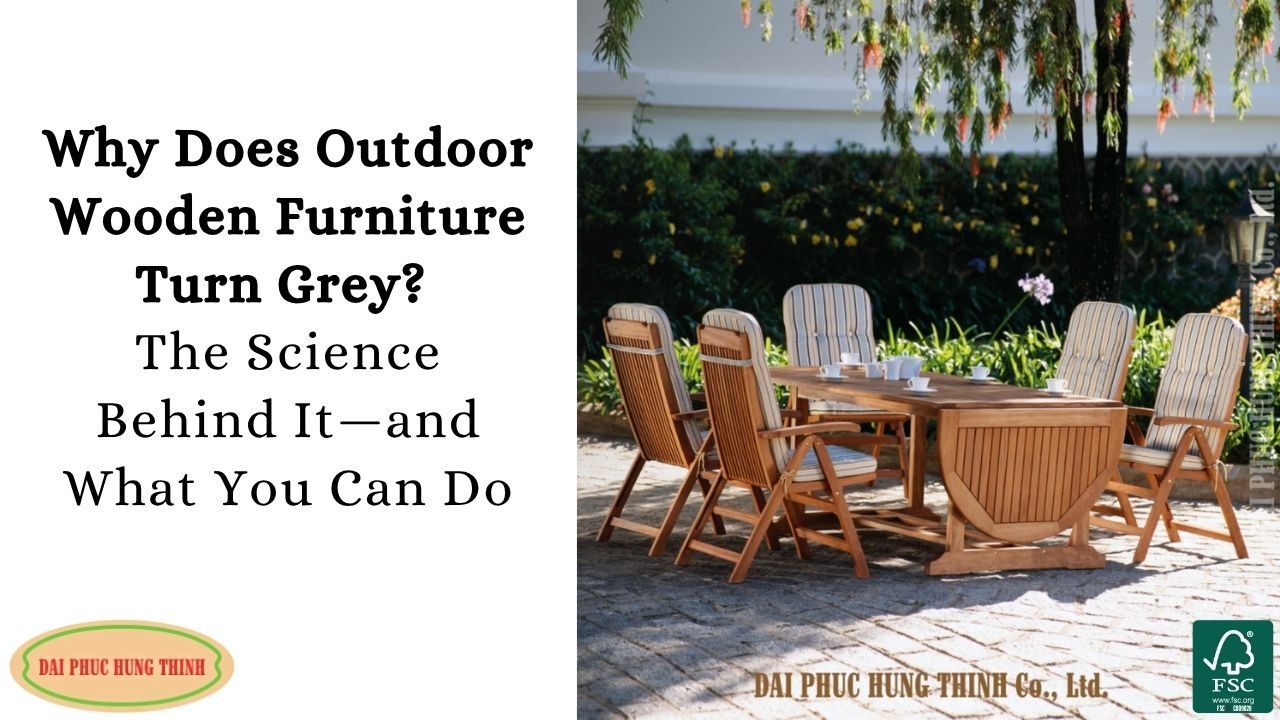When outdoor wooden furniture starts turning grey, many people assume it’s a sign of damage or decay. But in most cases, this color change is a natural and harmless process—one that occurs even in premium hardwoods like eucalyptus and acacia.
If you’re seeing a silvery-grey layer form on your outdoor chairs, tables, or loungers, don’t worry—you’re not alone. This phenomenon is common across North America and Europe and has a clear explanation rooted in wood science and weather exposure. In this guide, we’ll explain exactly why wood turns grey, whether it’s a problem, and how to prevent or reverse it.
1. What Causes Outdoor Wood to Turn Grey?
The greying of wood is a photodegradation process, caused primarily by ultraviolet (UV) radiation from sunlight. When UV rays penetrate the surface of the wood, they break down lignin—a structural compound in the wood that binds fibers together. As lignin degrades, it oxidizes and washes away with rain or moisture, exposing a dull, grey cellulose surface underneath.
This is a surface-level reaction, not an indication of mold, rot, or internal damage. It's similar to how newspaper turns yellow or how leather fades under prolonged sunlight. Add in humidity, rain, and temperature swings, and you get that weathered grey tone typical of aged outdoor furniture.
2. Are Acacia and Eucalyptus Prone to Greying?
Yes, but that’s not a flaw—it’s simply how natural hardwoods behave outdoors when untreated.
-
Acacia wood will turn grey within a few months of sun exposure if left unfinished. Despite its high density and natural oils, it still undergoes UV degradation at the surface.
-
Eucalyptus wood behaves similarly, developing a soft silver-grey patina over time. Like acacia, it’s incredibly durable but requires oiling to maintain its rich reddish-brown tone.
Even teak, often touted as the most weather-resistant hardwood, will turn grey without treatment. Greying is a universal trait of wood outdoors—it’s the treatment and maintenance that determines whether the color stays or changes.
3. Is Greying Bad for the Furniture?
Not at all. The grey color is purely cosmetic and doesn’t affect the wood’s strength or longevity—especially if the furniture is made from dense hardwoods like FSC-certified acacia or eucalyptus.
In fact, many homeowners love the weathered look. It gives the furniture a rustic, coastal, or vintage charm. But if you prefer the original color and smooth sheen, you’ll need to actively maintain the finish.

4. How to Prevent Greying
To keep your wooden furniture looking fresh and vibrant through the summer and beyond, follow these practices:
-
Oil your furniture regularly with a penetrating outdoor wood oil that contains UV blockers. This helps preserve color and adds a layer of moisture resistance.
-
Clean the surface every month using a soft brush and mild soapy water. Dirt and debris can trap moisture, speeding up surface deterioration.
-
Use breathable covers when not in use. Avoid plastic tarps that trap moisture and create mold; choose purpose-built covers designed for outdoor use.
At our factory, we pre-oil many acacia and eucalyptus products before shipment—but reapplication is needed at least once a season to maintain protection.\
5. How to Restore Original Wood Color
If your garden wooden furniture has already turned grey, you can restore it to its original tone with a few steps:
-
Light sanding: Use fine-grit sandpaper to gently remove the weathered surface layer. This reveals the natural color underneath.
-
Brightening solution: Apply a wood brightener (often oxalic acid-based) to neutralize grey pigments and bring out the wood’s color.
-
Rinse and dry: Let the furniture dry thoroughly before applying oil.
-
Re-oil: Finish with a fresh coat of UV-protective oil to preserve the newly restored tone.
These steps can revive furniture even after years of outdoor exposure—especially when the wood is high-quality, FSC-certified hardwood like what we use at our factory.
6. Why FSC-Certified Woods Like Eucalyptus and Acacia Are Ideal

Unlike tropical hardwoods like teak, which can take 20–30 years to mature, eucalyptus and acacia grow to harvestable size in just 7–10 years. This makes them more sustainable, especially when sourced from FSC-certified plantations, which follow strict environmental and social standards.
At Dai Phuc Hung Thinh Furniture, all of our acacia and eucalyptus furniture is made from 100% FSC-certified wood, ensuring traceability from forest to factory. Choosing FSC hardwoods isn’t just about doing the right thing—it’s also about choosing materials that are designed to thrive outdoors with the right care.
Final Thoughts
Outdoor wood greying is natural—but manageable. With regular maintenance and seasonal oiling, you can protect your furniture’s color or even embrace the patina it develops. Whether you love the weathered look or prefer the original finish, understanding the science behind greying helps you make better care decisions.
For End Consumers:
If you already own acacia or eucalyptus furniture—or you’re shopping for your next outdoor set—make sure to oil it regularly and use breathable covers. If you're unsure about care, ask your favorite furniture retailer whether they carry Dai Phuc Hung Thinh products. Our furniture is designed for long-term outdoor use and pre-treated for performance.
For Buyers & Retailers:
As a trusted Vietnam furniture manufacturer with over 22 years of experience, we provide retailers with high-quality, 100% FSC-certified outdoor furniture made from eucalyptus and acacia hardwood. We’ve supplied to top-tier brands like JYSK and Segmüller, and we offer flexible MOQs, personalized support, and transparent communication from sample to shipment.
📩 Interested in adding FSC-certified collections to your range?
Reach out to us at sales@daiphuchungthinh.com.vn
🌐 Explore our catalog: www.daiphuchungthinh.com.vn


